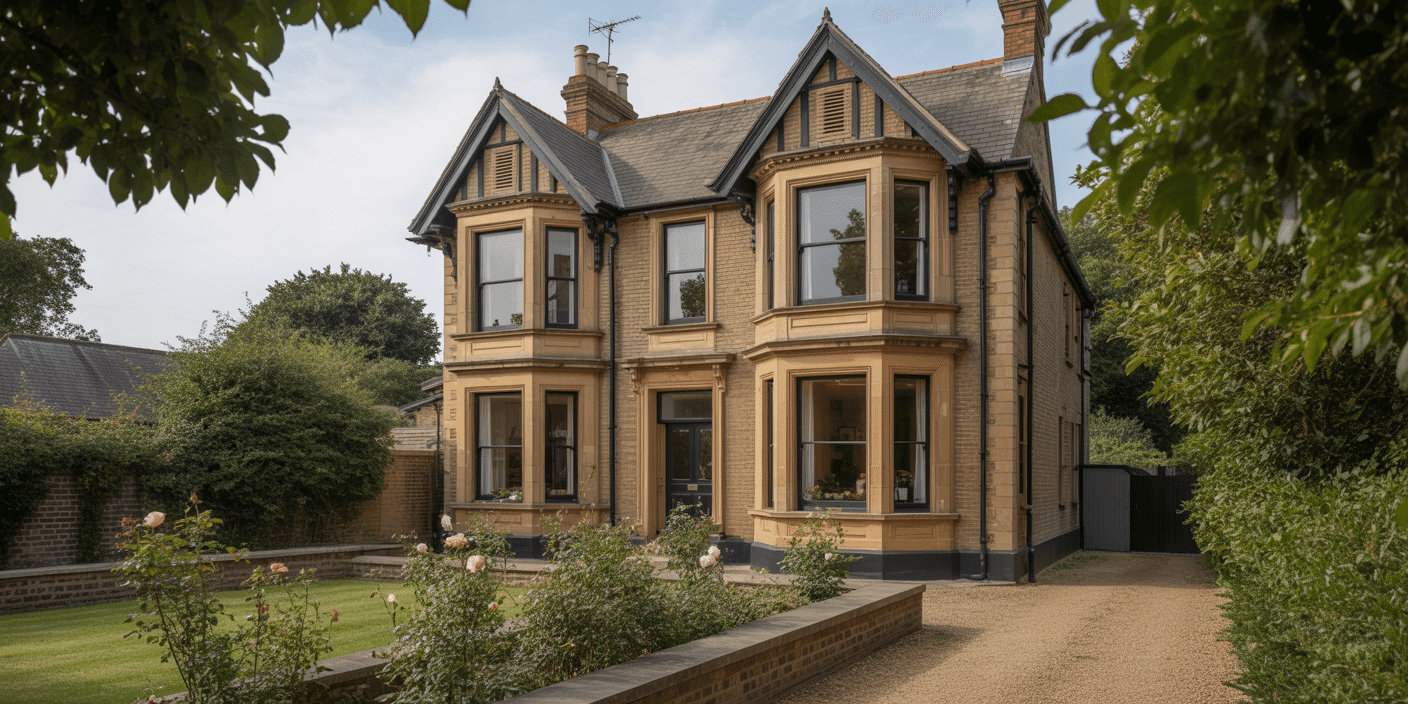What Every Heritage Property Owner Must Now Face
Appearances no longer suffice.
From 2025, revised UK building regulations will render thousands of traditional sash windows non-compliant—not in theory, but in enforceable law. For homeowners, developers, and property managers—particularly within London’s conservation zones or on listed buildings—this marks a critical turning point.
Sash windows, though historically revered for their craftsmanship and charm, are now subject to strict new standards under Part L (thermal efficiency), Part Q (security), and Part K (safety). Most existing installations—no matter how visually sympathetic—fail to meet these evolving criteria.
The implications are immediate and material:
- Rejected or stalled planning applications
- Increased break-in risk due to weak or outdated glazing systems
- Rising energy costs and substandard EPC ratings
- Insurance claims denied, premiums raised, or coverage withdrawn
- Long-term erosion of asset value for non-compliant heritage properties
Worse still, non-compliance is rarely obvious. Many property owners only discover the issue when applying for permission, commissioning a retrofit, or preparing for sale, by which point remediation is often complex, costly, and time-sensitive.
There is, however, a proven pathway forward.
It demands more than aesthetic sensitivity. It requires a deep, working knowledge of compliance frameworks, thermal engineering, glazing law, and conservation strategy—executed with precision, and certified to the letter.
Sash Windows London has built its reputation on precisely that.
The Beautiful Window That Might Be a Legal Liability
It’s easy to assume that if your sash windows look good, they must be good.
But beauty, in the eyes of a planning officer or building inspector, means nothing without compliance.
Every week, we hear from homeowners who believed their timber windows were “bespoke,” “approved,” or “conservation-friendly”—only to discover they were non-compliant, sometimes illegally so. The result?
❌ Failed planning applications
❌ Retrofit work ordered to be removed
❌ Uninsurable vulnerabilities
❌ Projects stalled for months
And it’s not just an issue for renovations. Even if your windows were installed just a few years ago, they may now be failing current UK Building Regulations in three critical areas:
- Energy Loss (Part L) – Are your windows thermally efficient enough to meet modern U-value requirements? Most aren’t.
- Weak Security (Part Q) – Could your windows withstand an impact test or forced entry? If not, they’re a risk.
- Fall Hazards (Part K) – Are your upper-level sashes compliant with fall protection rules? If not, you could be liable.
Heritage homes are especially vulnerable. That’s because their charm often comes with fragile glass, outdated mechanisms, and legacy joinery that simply doesn’t meet the technical demands of 2025’s regulations.
And here’s the real danger:
Most builders, joiners, and even architects don’t fully understand these evolving standards—let alone how to meet them without compromising the property’s character.
At Sash Windows London, we do.
We specialise in protecting what’s beautiful while upgrading what’s necessary.
Because in today’s regulatory climate, your window isn’t just a design feature.
It’s a compliance threshold—and if it fails, everything else falls with it.
What Parts L, Q & K Actually Require (And Why It’s Not Obvious)

The regulations shaping the future of your sash windows aren’t optional—they’re statutory. And while they sound like dry legal code, Parts L, Q, and K are directly responsible for the most common planning rejections and retrofit failures in the UK.
Let’s decode them simply.
Part L – Thermal Efficiency
“Make it warm, or make it again.”
Part L governs the energy performance of buildings. For windows, that means strict U-value targets—essentially, how well your glazing retains heat.
Traditional single glazing?
Fails Part L.
Most timber-framed double glazing from 10 years ago?
Still fails Part L.
To comply, modern sash windows must:
- Use Low-E (low emissivity) glass
- Be double- or triple-glazed, preferably with argon gas
- Feature thermally broken frames (to prevent cold bridging)
- Achieve U-values of 1.4 W/m²K or lower
But here’s the twist: In conservation zones, you can’t just whack in chunky triple glazing. That’s where slimline double glazing comes in—thin enough to mimic the aesthetic of traditional single panes, but powerful enough to meet Part L head-on.
Part Q – Security Compliance
“It must look traditional. But it must act like a fortress.”
Introduced to reduce break-ins in new and refurbished homes, Part Q mandates that windows and doors resist unauthorised entry.
For sash windows, that means:
- Laminated or toughened glass
- PAS 24–rated locking mechanisms
- Reinforced frame construction
- Glazing beads and hinges that resist forced entry
Most off-the-shelf joinery shops don’t build to Part Q.
We do. Quietly. Elegantly. Without ruining the lines of your period property.
Part K – Fall Protection
“Open beautifully. But never dangerously.”
Part K exists to prevent falls from windows—especially in upper-storey sashes, children’s rooms, or loft conversions.
If your sash windows open too wide or lack compliant restrictors, you’re in breach.
It’s not just a safety issue—it can void planning approval or insurance coverage.
Our team integrates hidden travel restrictors and compliant sill heights into your sash design—keeping both the inspector and the occupants happy.
Why Most Suppliers Get This Wrong
Because many sash windows are still sold on appearance, not performance.
They’re beautiful—but they’re legally blind.
Sash Windows London begins every project with these standards in mind.
From joinery specs to glazing thickness, locking systems to U-value reports—we build for passion, preservation, and planning approval.
You don’t have to know all the clauses.
You just need a partner who does.
The Heritage Trap: Why Listed Buildings & Conservation Zones Are a Minefield
Owning a heritage property is a privilege—until it becomes a puzzle.
If your home sits within a conservation area or holds listed status, replacing or upgrading your sash windows isn’t just a matter of taste or budget. It’s a planning minefield, and one wrong move can set your entire project back months, or worse, result in an enforcement notice to undo the work.
Many homeowners don’t realise this until it’s too late.
Conservation Areas: Where Authenticity Meets Regulation
Conservation areas exist to preserve the visual character of historically significant streetscapes. And windows, more than any other architectural feature, are under the microscope.
The mistake? Installing double glazing or modern frames that look slightly off.
Even subtle deviations in:
- Glazing bar thickness
- Glass reflectivity
- Putty line profiles
- Or timber species
…can trigger a rejection from your local planning authority.
Standard double glazing often bulks out the sash—disrupting proportions that have existed since the 1800s.
Worse, UPVC or aluminium framed options can breach the character test immediately.
Listed Buildings: The Planning Officer’s Chess Game
If your property is listed, you’re dealing with national legislation, not just local guidelines. That means:
- You must apply for Listed Building Consent (LBC)
- You cannot rely on permitted development rights
- Every material, detail, and method is scrutinised
This isn’t just about preserving appearances—it’s about preserving integrity.
Planning officers will ask:
- Is the glazing original or a replacement?
- Is it repairable rather than replaceable?
- Does the proposed unit maintain historic proportions and materials?
Where Most Joinery Firms Fail—and Where Sash Windows London Wins
Most companies sell “period-style” sash windows.
But they’re not heritage compliant. They’re often:
- Too thick
- Poorly proportioned
- Lacking documented glazing specs or planning support
At Sash Windows London, we don’t guess. We:
- Use slimline heritage-approved glazing that looks like single glass—but passes Part L
- Offer joinery matched to your original profiles, crafted from FSC-certified timber
- Provide full planning pack support, including CAD drawings, heritage statements, and liaison with local authorities
- Understand the nuance of your borough’s conservation officers (because we’ve worked with them)
“We make your planning officer say yes the first time—without compromising your property’s soul.”
That’s not marketing.
That’s the result of two decades navigating London’s most complex heritage sites.
Your windows should be admired by neighbours, not flagged by planning.
With the right approach, they can be both.
The Solution Stack: Glazing Technology That Quietly Wins Approvals

Here’s the truth few will tell you:
You can have thermally efficient, secure, and regulation-compliant sash windows without compromising on heritage charm.
But only if every detail—from the glazing spec to the bead profile—is engineered with intent.
That’s where Sash Windows London excels: a product suite crafted not just for aesthetics, but for planning approval, thermal reports, and security testing—all while satisfying the sharp eye of a heritage officer.
Your Approval-Ready Retrofit Toolkit
| Component | What It Solves | Regulatory Benefit |
| Slimline Double Glazing | Ultra-thin cavity fits original sash proportions | Meets Part L without upsetting conservation aesthetics |
| Low-E Coated Glass | Reflects interior heat, improves U-values | Required for thermal efficiency (Part L) |
| Laminated Security Glass | Withstands impact and forced entry | Complies with Part Q (PAS 24 standard) |
| Thermally Broken Frames | Stops cold bridging through timber or composite | Reduces energy loss (Part L + SAP targets) |
| Alu-Clad Timber Hybrid Frames | Offers durability + traditional aesthetic | Suitable for high-exposure zones / Part Q |
| Hidden Travel Restrictors | Prevents sashes from opening beyond the safe limit | Meets Part K (fall protection) |
| FENSA Certified Install | Verified installation standard | Delivers essential sign-off & compliance evidence |
The Engineering of Elegance
Too many firms sell “heritage-style” windows that look the part but fail the tests.
The result? They get flagged during planning, rejected on SAP calculations, or retrofitted again—at your expense.
Our systems are different. Every frame, glass unit, locking mechanism, and sightline is chosen to hit three simultaneous targets:
- Conservation Officers → Looks original
- Building Inspectors → Proves performance
- Homeowners → Feels warmer, safer, and quieter
And because we handle design, manufacture, and installation under one roof, there’s no guesswork.
Your home gets the complete solution, not a patchwork of compromises.
“We don’t just build windows—we build planning-ready systems that glide through approval, meet every legal requirement, and elevate your home’s value.”
The days of choosing between beauty and compliance are over.
Now, you can retrofit for 2025—and look like you belong in 1825.
The Proof: Real Clients. Real Homes. Real Compliance.
“It was either rip out our original sash windows—or find someone who knew how to save them. Sash Windows London didn’t just restore them. They future-proofed our entire home.”
— Charlotte M., Islington homeowner, listed property
At Sash Windows London, we don’t just talk about compliance, craftsmanship, and conservation—we prove it. Every week, we deliver solutions that strike the perfect balance between planning approval and modern performance. Below are just a few real-world stories that show how:
Case Study 1: Georgian Townhouse, Kensington – From ‘Planning Nightmare’ to Showpiece Approval
The Problem:
The homeowners submitted their own glazing upgrade proposal—rejected. The windows were too thick, the glazing too reflective, and the frames not historically accurate.
What We Did:
- Produced CAD-drafted joinery replicas of original sash units
- Installed 12mm slimline double glazing with Low-E coating
- Submitted a full Heritage Statement and liaised directly with the borough planning officer
- Delivered full FENSA certification and compliance pack
Result:
Approval granted on first resubmission. Heating bills down 28%.
Planning officer quote: “Exceptional attention to heritage integrity.”
Case Study 2: Victorian Terrace in Camden – Cold, Unsafe, and Failing Every Test
The Problem:
The existing sash windows rattled in their frames. Single-glazed, warped, and insecure. The homeowner feared both burglars and the heating bill.
What We Did:
- Installed laminated security glass to meet Part Q
- Reinforced traditional timber frames with a thermally broken core
- Integrated hidden restrictors and locks to meet Part K
- Produced documentation for lender and insurance compliance
Result:
No more draughts. 2°C warmer in winter. Passed post-renovation energy audit with flying colours.
Case Study 3: Grade II Listed Property, Greenwich – Told “It Can’t Be Done”
The Problem:
The client had been told by multiple suppliers that they couldn’t double-glaze the sashes due to listing restrictions.
What We Did:
- Created like-for-like slimline units using 14mm heritage glass
- Matched original putty line detail and horn profiles
- Worked with conservation consultants to justify design in Listed Building Consent
- Delivered all planning-ready drawings and approvals
Result:
Approved. Installed. And indistinguishable from the original—except for the comfort.
Why This Matters
Anyone can sell you a window.
But not everyone can deliver a compliance-backed system that’s been tested on the front lines of planning, conservation, and structural performance.
We’ve worked with:
- Historic England
- Local councils across London boroughs
- Private architects and conservation consultants
- Homeowners with everything to lose—and everything to preserve
Sash Windows London doesn’t promise the easiest path.
We deliver the right one—and get you there with confidence.
You don’t need to gamble with your glazing.
You need a partner with a track record.
And now, you’ve found them.
Why 2025 Will Make This Even More Urgent
There’s a quiet but dramatic shift unfolding in the world of property compliance—and most homeowners haven’t seen it coming.
By 2025, new building regulations, climate performance standards, and planning enforcement protocols will make today’s “good enough” windows legally—and financially—obsolete.
If you’re thinking about retrofitting your sash windows in the next 6–12 months, here’s what you must understand:
Tighter U-Value Thresholds Are Coming
The UK’s commitment to Net Zero by 2050 means thermal performance standards are rising across the board.
By 2025:
- SAP (Standard Assessment Procedure) scores will weigh window U-values more heavily
- Non-compliant windows will drag down EPC ratings, affecting property value and salability
- Listed and heritage properties will no longer be “exempt” from performance scrutiny
Translation? If you’re still using single glazing or old double glazing, you’re on borrowed time.
Security Standards Will Be Enforced More Rigorously
As home security becomes a national agenda item, Part Q enforcement is tightening—especially in cities like London.
Insurance companies are beginning to:
- Request proof of PAS 24–rated systems
- Refuse coverage for break-ins via non-compliant windows
- Raise premiums on period properties with inadequate security specs
If your windows are vulnerable, you’re not just risking theft. You’re risking financial liability.
Non-Compliant Windows Could Devalue Your Home
More buyers than ever are requesting:
- Pre-sale FENSA documentation
- EPC ratings above C
- Evidence of heritage-compatible retrofits
Without these?
They walk. Or they negotiate you down—aggressively.
Planning Officers Are Enforcing Harder Than Ever
Whereas minor breaches once slipped through, London boroughs are now:
- Inspecting window replacement applications with microscopic detail
- Demanding complete joinery profiles and glazing reports
- Issuing stop notices for non-compliant installations—often after work is done
What It All Means
2025 isn’t just another year on the calendar.
It’s a compliance cliff.
The homeowners who act now will:
- Glide through planning
- Future-proof their investment
- Save thousands in rework, insurance, and heating bills
The ones who delay?
They’ll face more red tape, higher costs, and shrinking choices.
This isn’t about urgency for urgency’s sake. It’s about staying ahead of a system that’s getting stricter, faster—and never looking back.
Sash Windows London has already built for the next generation of compliance.
We know what’s coming.
And we’re ready to take you there—before the window closes.
Compliance. Comfort. Confidence — Get All Three Today
If you’ve read this far, you already understand something most homeowners don’t:
Your sash windows aren’t just decorative. They’re regulatory thresholds. And in 2025, they’ll either pass—or they won’t.
You could:
- Hope your current glazing meets the new standards
- Risk the delays and embarrassment of a failed planning application
- Gamble with draughts, break-ins, or rejected insurance claims
Or you could future-proof your home today, with a team that has spent over 20 years guiding heritage properties safely through every change in regulation, planning law, and glazing technology.
What You’ll Get With Sash Windows London:
- A full compliance-ready assessment of your existing sash windows
- Tailored solutions for Part L, Part Q, and Part K
- Planning support for conservation areas and listed buildings
- Expert joinery and glazing systems that pass inspections — and win praise
- The comfort of knowing you’re warm, secure, and future-ready
“We don’t just make windows. We make certainty.”
– Sash Windows London
Ready to Retrofit With Confidence?
Start with a Free Compliance Consultation — we’ll review your current setup and give you a clear, no-obligation roadmap to 2025 readiness.
📞 Call us today or
📩 Request your FREE Glazing Compliance Pack — filled with Part L/Q/K guidance, joinery profiles, and approval checklists.
The best time to secure your home’s future was yesterday.
The next best time is now.
Let’s protect what makes your property special—without risking what makes it legal.







